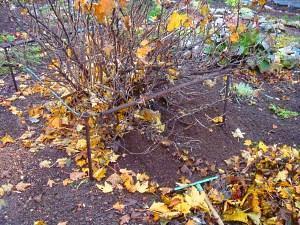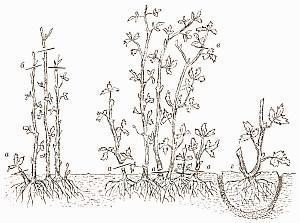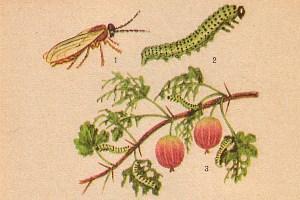Necessary processing of gooseberries after harvest
 Gooseberries are popular among gardeners for their excellent yields. In order for a shrub to bear fruit for a long time, it should be given enough attention. Processing gooseberries in autumn is one of the important stages of caring for bushes. During this period, it is necessary to help the plantings prepare not only for winter, but also for the next harvest.
Gooseberries are popular among gardeners for their excellent yields. In order for a shrub to bear fruit for a long time, it should be given enough attention. Processing gooseberries in autumn is one of the important stages of caring for bushes. During this period, it is necessary to help the plantings prepare not only for winter, but also for the next harvest.
What is the processing of gooseberries in the fall?
To ensure the best conditions, it is necessary to perform a number of measures for processing gooseberries:
- collect and burn old leaves and weeds;
- cut off old, diseased and broken branches;
- water the plantings if necessary;
- process and dig up the soil around the bush;
- feed with mineral and organic fertilizers;
- process gooseberries from diseases and pests;
- mulch the soil under the bush.
All of the above measures for processing gooseberries after harvest, it is better not to postpone until later. Let us consider in more detail the agricultural technology for processing gooseberries.
Read also the article:gooseberry disease description with photos and treatment methods!
How to handle gooseberries after harvest?
Gooseberry cultivation begins with weeding around the bush. If weeding was not carried out throughout the summer, then under the bushes many small and large weeds grew. They should not be pulled out, as the roots may remain in the soil, but carefully dig up with a shovel so as not to damage the gooseberry. It is also necessary to use a rake to collect the accumulated debris and fallen leaves, since many pests and pathogens of various diseases remain under it to winter.
 Gooseberry pruning should be started at the age of 6. The weak root growth must be cut out the next year after planting the shrub, choosing 3 - 4 strong shoots. First of all, broken branches are cut out, damaged by diseases and pests, old and infertile. A well-formed bush should have up to 18 branches of various ages, sparse enough to allow light and air to enter the interior of the bush and facilitate subsequent harvests.
Gooseberry pruning should be started at the age of 6. The weak root growth must be cut out the next year after planting the shrub, choosing 3 - 4 strong shoots. First of all, broken branches are cut out, damaged by diseases and pests, old and infertile. A well-formed bush should have up to 18 branches of various ages, sparse enough to allow light and air to enter the interior of the bush and facilitate subsequent harvests.
How to trim gooseberries correctly - video:
After the foliage has fallen off during a dry autumn and a large harvest, it is necessary to water the gooseberries. Such watering is very important on light and sandy loam soils. This enhances root growth, and the bush is better prepared for frost.
For good development of the bush and regular fruiting, it is necessary to dig up and loosen the soil. Unlike spring digging, during autumn the soil is not broken, but turned over with a pitchfork, since large lumps retain moisture in the soil in autumn and spring. Gooseberry roots are located close to the soil surface, therefore, under the crown of the bush, processing should be done very carefully, to a depth of no more than 7 cm.
In connection with the abundant fruiting, gooseberries need enhanced feeding.
During digging, the following fertilizers are applied to the soil under one bush:
- up to 10 kg of compost or rotted manure;
- 20 gr. potash fertilizers (potassium sulfate);
- 30 gr. phosphorus fertilizers (double superphosphate );
- 300 gr. furnace ash.
The best result will be given by liquid organic fertilizer in the form of a diluted infusion of mullein or bird droppings.
The task of these dressings is to prepare the shrub for the laying of flower buds next year.
It is advisable to sprinkle humus or peat mixed with ash on top of the soil dug under the bush to a thickness of no more than 10 cm.This layer covers both the inner zone of the bush and the bite strip. Mulching improves the water-air, temperature and nutritional regime of the upper soil layer, prevents the roots from freezing, and reduces the growth of weeds. It is advisable to mulch the soil before the onset of frost.
Treatment of gooseberries from diseases and pests
 In the fall, it is necessary to treat gooseberries from diseases and pests.
In the fall, it is necessary to treat gooseberries from diseases and pests.
An effective means of combating fungal diseases is iron vitriol; bushes are treated with a 3% solution after the leaves fall. A 1-3% solution of Bordeaux liquid is also used.
A 5% baking soda solution is used to combat powdery mildew. To protect against septoria, anthracnose or goblet rust, gooseberries and the soil under them should be treated with oxychloride (40 grams per 10 liters of water), soap-copper emulsion or ash infusion. All fallen leaves should be burned.
To protect against aphids, fireflies or sawflies, gooseberries should be treated in the fall with a solution of karbofos (20 grams per 10 liters of water), an infusion of ash (1 kg per 10 liters of water) or infusions of onion peels, chopped garlic or potato tops.
All the measures taken for the processing of gooseberries will have a beneficial effect on growth and productivity.